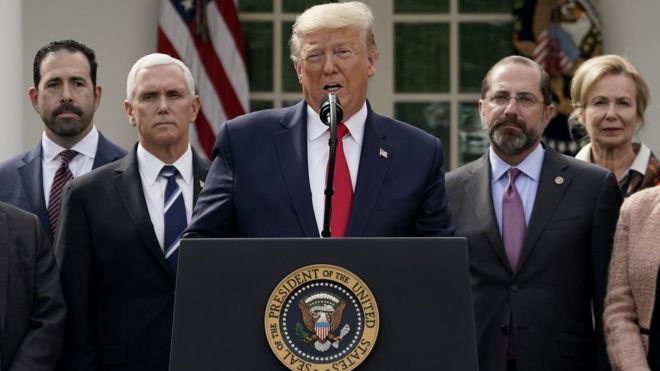U.S. President Donald Trump on Friday declared a national emergency over the fast-spreading coronavirus, opening the door to providing what he said was about $50 billion in federal aid to fight the disease.
Trump made the announcement at a Rose Garden news conference.
Trump said he was declaring the national emergency in order to “unleash the full power of the federal government.” He urged every state to set up emergency centers to help fight the virus.
Pressure has been mounting for Trump to declare an infectious disease emergency under the 1988 law that would allow the Federal Emergency Management Agency (FEMA) to provide disaster funds to state and local governments and to deploy support teams.
The power is rarely used. Former President Bill Clinton in 2000 declared such an emergency for West Nile virus.
WHAT IS THE STAFFORD ACT?
The law, enacted in 1988, empowers the Federal Emergency Management Agency (FEMA) to assist state and local governments during “natural catastrophes” and coordinate the nation’s response.
FEMA, an agency within the U.S. Department of Homeland Security, controls more than $40 billion in federal funding set aside by Congress for disaster relief. FEMA could use that funding to help build medical facilities and transport patients, among other measures.
Only the president can declare a major disaster under the law.
“We have very strong emergency powers under the Stafford Act,” Trump told reporters in the Oval Office on Thursday. “I have it memorized, practically, as to the powers in that act. And if I need to do something, I’ll do it. I have the right to do a lot of things that people don’t even know about.”
Trump has invoked the Stafford Act many times during his presidency, approving major disaster declarations to address flooding in the Midwest and wildfires in California, among other events.
FEMA is commonly associated with natural disaster responses but the agency can also address pandemics.
In 2000, former President Bill Clinton used a Stafford Act emergency declaration to pay for mosquito control efforts to address outbreaks of the West Nile virus in New Jersey and New York.
DIDN’T THE U.S. ALREADY DECLARE CORONAVIRUS AN EMERGENCY?
A different government agency, the U.S. Department of Health and Human Services, declared the coronavirus a public health emergency in late January and has been the lead agency addressing the pandemic.
HHS’s declaration, made under a different law than the Stafford Act, allowed U.S. officials to impose restrictions on individuals entering the country from China, among other measures.
Several state governments have declared emergencies, allowing them to mandate containment zones like the one in New Rochelle, New York, and address price-gouging.
WHAT OTHER LAWS COULD TRUMP INVOKE?
Last year, Trump declared an emergency on the U.S.-Mexican border to circumvent Congress and take money already designated for other programs to pay for his wall on the souther border, which he promised to build during his 2016 campaign.
That declaration was made under the National Emergencies Act of 1976. The law does not define “emergency,” giving the president broad discretion to declare one.
An emergency declaration under the National Emergencies Act unlocks sweeping presidential powers, like the ability to seize control of the internet or suspend laws, while a Stafford Act declaration deals only with FEMA.
In 2009, former President Barack Obama declared the H1N1 influenza, or “swine flu,” pandemic to be a national emergency under that law.
Obama’s declaration waived some federal health insurance rules to speed treatment.
Source: Reuters


